Ginger (Zingiber officinale Roscoe), Lemon (Citrus limon L.) Juices as Preventive Agents from Chronic Liver Damage Induced by CCl4: A Biochemical and Histological Study
Abstract
1. Introduction
2. Material and Methods
2.1. Plant Material
2.2. Preparation of Zingiber officinale (GJ) and Citrus limon (LJ) Juices
2.3. Quantification of Secondary Metabolites
2.3.1. Total Polyphenol Content
2.3.2. Total Flavonoids of Ginger and Lemon Juices
2.4. Qualitative and Semi-Quantitative Analysis of Ginger and Lemon Juices
2.5. Antioxidant Activity
2.5.1. Antiradical Scavenging Activity against DPPH
2.5.2. Ferric Reducing Power Assay (FRAP)
2.5.3. Total Antioxidant Capacity (TAC)
2.6. Hepatoprotective Activity
2.6.1. Animals
2.6.2. Ethical Approval
2.6.3. Experimental Design
2.6.4. Histopathological Study
2.7. Statistical Analysis
3. Results
3.1. Extraction and Chemical Composition of Zingiber officinale and Citrus limon
3.2. Antioxidant Activity
3.2.1. Radical Scavenging Activity
3.2.2. Ferric Reducing Assay
3.2.3. Total Antioxidant Activity
4. Hepatoprotective Activity
4.1. Biochemical Analyses
4.2. Histopathological Study
5. Discussion
6. Conclusions
Author Contributions
Funding
Institutional Review Board Statement
Informed Consent Statement
Data Availability Statement
Conflicts of Interest
References
- Bates, B.; Bickley, L.S. GUIDE de L’examen Clinique-Nouvelle Edition 2014; Arnette-John Libbey Eurotext: Arcueil, France, 2014. [Google Scholar]
- Loichot, G. Introduction à la Pharmacocinétique, Passages Transmembranaires; Pharmacologie Générale: Strasbourg, France, 2004. [Google Scholar]
- Liu, J.; Qu, W.; Kadiiska, M.B. Role of oxidative stress in cadmium toxicity and carcinogenesis. Toxicol. Appl. Pharmacol. 2009, 238, 209–214. [Google Scholar] [CrossRef] [PubMed]
- Damintoti, K.; Dicko, M.H.; Simpore, J.; Traore, A.S. Antioxidant and antibacterial activities of polyphenols from ethnomedicinal plants of Burkina Faso. Afr. J. Biotechnol. 2005, 4, 823–828. [Google Scholar]
- Cordell, G.A.; Colvard, M.D. Natural Products and Traditional Medicine: Turning on a Paradigm. J. Nat. Prod. 2012, 75, 514–525. [Google Scholar] [CrossRef] [PubMed]
- Compaore, S.; Belemnaba, L.; Hounkpevi, A.; Idohou, R.; Zerbo, I. Diversity of plants used in the management of hypertension by three associations of traditional healers along a climate gradient in Burkina Faso. Adv. Tradit. Med. 2020, 21, 151–162. [Google Scholar] [CrossRef]
- Balunas, M.J.; Kinghorn, A.D. Drug discovery from medicinal plants. Life Sci. 2005, 78, 431–441. [Google Scholar] [CrossRef]
- Hamilton, A.C. Medicinal plants, conservation and livelihoods. Biodivers. Conserv. 2004, 13, 1477–1517. [Google Scholar] [CrossRef]
- Hachi, M.; Hachi, T.; Belahbib, N.; Dahmani, J.; Zidane, L. Contribution à l’étude floristique et ethnobotanique de la flore médicinale utilisée au niveau de la ville de Khenifra (Maroc). Int. J. Innov. Appl. Stud. 2015, 11, 754–770. [Google Scholar]
- Enstitüsü, Growing and Plant Characteristics of Ginger (Zingiber officinale Roscoe). Food Agiculture Organ. 2015, 22, 1–9.
- Ali, B.H.; Blunden, G.; Tanira, M.O.; Nemmar, A. Some phytochemical, pharmacological and toxicological properties of ginger (Zingiber officinale Roscoe): A review of recent research. Food Chem. Toxicol. 2008, 46, 409–420. [Google Scholar] [CrossRef]
- Alami, Z.; Aynaou, H.; Alami, B.; Hdidou, Y.; Latrech, H. Herbal medicines use among diabetic patients in Oriental Morocco. J. Pharmacogn. Phyther. 2015, 7, 9–17. [Google Scholar]
- Irannejad, A.; Khatamsaaz, S.; Mokhtari, M.J. The effects of hydro-alcoholic extract of zingiber officinale (Ginger) on pparγ gene expression, the blood lipid profiles and the liver enzymes (ast, alt) in the high-fat diet-fed adult male rats. Eur. Asian J. Biosci. 2020, 14, 2015–2021. [Google Scholar]
- Bekkouch, O.; Harnafi, M.; Touiss, I.; Khatib, S.; Harnafi, H.; Alem, C.; Amrani, S. In Vitro Antioxidant and in Vivo Lipid-Lowering Properties of Zingiber officinale Crude Aqueous Extract and Methanolic Fraction: A Follow-Up Study. Evidence-based Complement. Altern. Med. 2019, 2019, 1–13. [Google Scholar]
- Danciu, C.; Vlaia, L.; Fetea, F.; Hancianu, M.; Coricovac, D.E.; Ciurlea, S.A.; Şoica, C.M.; Vlaia, V.; Dehelean, C.A.; Trandafirescu, C. Evaluation of phenolic profile, antioxidant and anticancer potential of two main representants of Zingiberaceae family against B164A5 murine melanoma cells. Biol. Res. 2015, 48, 1–9. [Google Scholar] [CrossRef]
- Taha, N.M.; Mandour, A.A.; Lebda, M.A. Antioxidative and cardio-protective effects of ehatnolic extract of ginger on triton WR-1339 induced hyperlipidemia in rats. Int. J. Chem. Res. 2014, 6, 153–158. [Google Scholar]
- Kim, H.J.; Kim, B.; Mun, E.G.; Jeong, S.Y.; Cha, Y.S. The antioxidant activity of steamed ginger and its protective effects on obesity induced by high-fat diet in C57BL/6J mice. Nutr. Res. Pract. 2018, 12, 503–511. [Google Scholar] [CrossRef]
- Elkirdasy, A.; Shousha, S.; Alrohaimi, A.H. Hematological and immunobiochemical study of green tea and ginger extracts in experimentally induced diabetic rabbits. Acta Pol. Pharm.-Drug Res. 2015, 72, 497–506. [Google Scholar]
- Iroaganachi, M.; Eleazu, C.O.; Okafor, P.N.; Nwaohu, N. Effect of Unripe Plantain (Musa paradisiaca) and Ginger (Zingiber officinale) on Blood Glucose, Body Weight and Feed Intake of Streptozotocin-induced Diabetic Rats. Open Biochem. J. 2015, 9, 1–6. [Google Scholar]
- Goetz, P. Citrus limon (L.) Burm. f.(Rutacées) Citronnier. Phytothérapie 2014, 12, 116–121. [Google Scholar] [CrossRef]
- Debuigne, G.; Couplan, F. Petit Larousse des Plantes Qui Guérissent; Larousse: Paris, France, 2008; p. 895. [Google Scholar]
- Tag, H.M.; Kelany, O.E.; Tantawy, H.M.; Fahmy, A.A. Potential anti-inflammatory effect of lemon and hot pepper extracts on adjuvant-induced arthritis in mice. J. Basic Appl. Zool. 2014, 67, 149–157. [Google Scholar] [CrossRef]
- Haidari, F.; Mohammadshahi, M.; Zarei, M.; Fathi, M. Protective effect of citrus lemon on inflammation and adipokine levels in acrylamide-induced oxidative stress in rats. Braz. J. Pharm. Sci. 2019, 55, 1–7. [Google Scholar] [CrossRef]
- Lee, H.; Woo, M.; Kim, M.; Noh, J.S.; Song, Y.O. Antioxidative and cholesterol-lowering effects of lemon essential oil in hypercholesterolemia-induced rabbits. Prev. Nutr. Food Sci. 2018, 23, 8–14. [Google Scholar] [CrossRef]
- Aazza, S.; Lyoussi, B.; Miguel, M.G. Antioxidant and antiacetylcholinesterase activities of some commercial essential oils and their major compounds. Molecules 2011, 16, 7672–7690. [Google Scholar] [CrossRef]
- Klimek-Szczykutowicz, M.; Szopa, A.; Ekiert, H. Citrus limon (Lemon) phenomenon—a review of the chemistry, pharmacological properties, applications in the modern pharmaceutical, food, and cosmetics industries, and biotechnological studies. Plants 2020, 9, 119. [Google Scholar] [CrossRef]
- Ainsworth, E.A.; Gillespie, K.M. Estimation of total phenolic content and other oxidation substrates in plant tissues using Folin–Ciocalteu reagent. Nat. Protoc. 2007, 2, 875–877. [Google Scholar] [CrossRef] [PubMed]
- Dehpour, A.A.; Ebrahimzadeh, M.A.; Fazel, N.S.; Seyed, N. Mohammad, Antioxidant activity of the methanol extract of Ferula assafoetida and its essential oil composition. Grasas Y Aceites 2009, 60, 405–412. [Google Scholar]
- Patel, R.; Rinker, L.; Peng, J.; Chilian, W.M. Reactive Oxygen Species: The Good and the Bad. React. Oxyg. Species Living Cells 2018, 7. [Google Scholar]
- Di Meo, S.; Reed, T.T.; Venditti, P.; Victor, V.M. Role of ROS and RNS Sources in Physiological and Pathological Conditions. Oxid. Med. Cell. Longev. 2016, 2016, 1–44. [Google Scholar] [CrossRef]
- Liguori, I.; Russo, G.; Curcio, F.; Bulli, G.; Aran, L.; Della-Morte, D.; Gargiulo, G.; Testa, G.; Cacciatore, F.; Bonaduce, D. Oxidative stress, aging, and diseases. Clin. Interv. Aging 2018, 13, 757–772. [Google Scholar] [CrossRef]
- Tiencheu, B.; Njabi Nji, D.; Ufuan Achidi, A.; Egbe, A.C.; Tenyang, N.; Tiepma Ngongang, E.F.; Tonfack Djikeng, F.; Tatsinkou Fossi, B. Heliyon shelf-life studies of natural fruit juice formulated from orange (Citrus sinensis), lemon (Citrus limon), Honey and Ginger (Zingiber officinale). Heliyon 2021, 7, e07177. [Google Scholar] [CrossRef]
- Maizura, M.; Aminah, A.; Wan Aida, W.M. Total phenolic content and antioxidant activity of kesum (Polygonum minus), ginger (Zingiber officinale) and turmeric (Curcuma longa) extract. Int. Food Res. J. 2011, 18, 526–531. [Google Scholar]
- Harsha, H.; Aarti, S. Quality Evaluation of Herbal Juice Developed from Traditional Indian Medicinal Plants Using Citrus limetta as Base. Nutr. Food Sci. 2016, 5, 1–5. [Google Scholar]
- Gironés-Vilaplana, A.; Valentão, P.; Andrade, P.B.; Ferreres, F.; Moreno, D.A.; García-Viguera, C. Phytochemical profile of a blend of black chokeberry and lemon juice with cholinesterase inhibitory effect and antioxidant potential. Food Chem. 2012, 134, 2090–2096. [Google Scholar] [CrossRef]
- Makni, M.; Jemai, R.; Kriaa, W.; Chtourou, Y.; Fetoui, H. Citrus limon from Tunisia: Phytochemical and Physicochemical Properties and Biological Activities. Biomed Res. Int. 2018, 2018, 1–10. [Google Scholar] [CrossRef]
- Sharma, S.; Kumar, R. Antioxidant activity, TLC and phytochemical analysis of ginger (Zingiber officinale L.) rhizome. Plant Arch. 2018, 18, 210–214. [Google Scholar]
- Al, J.; Baqir, E.; Al, A.; Al, T.; Husain, A.; Alam, S. Phytochemical Screening, Phenolic Content and Antioxidant Activity of Citrus aurantifolia L. Leaves Grown in Two Regions of Oman. Iran. J. Pharm. Sci. 2018, 14, 27–34. [Google Scholar]
- Fejzić, S.; Ćavar, A. Phenolic Compounds and Antioxidant Activity of Some Citruses. Bull. Chem. Technol. Bosnia Herzeg. 2014, 42, 1–4. [Google Scholar]
- Mditshwa, A.; Bower, J.P.; Bertling, I.; Mathaba, N.; Investigation of the Efficiency of the Total Antioxidants Assays in Silicon-Treated Lemon Fruit (Citrus limon). In Africa Horticulture Congress; Acta Horticulturae: 2013; pp. 93–102. Available online: https://www.ishs.org/publications (accessed on 26 January 2022).
- Mao, Q.-Q.; Xu, X.-Y.; Cao, S.-Y.; Gan, R.-Y.; Corke, H.; Beta, T.; Li, H.-B. Bioactive compounds and bioactivities of ginger (zingiber officinale roscoe). Foods 2019, 8, 185. [Google Scholar] [CrossRef]
- Masuda, Y.; Kikuzaki, H.; Hisamoto, M.; Nakatani, N. Antioxidant properties of gingerol related compounds from ginger. BioFactors 2004, 21, 293–296. [Google Scholar] [CrossRef]
- Tsimogiannis, D.I.; Oreopoulou, V. The contribution of flavonoid C-ring on the DPPH free radical scavenging efficiency. A kinetic approach for the 3′,4′-hydroxy substituted members. Innov. Food Sci. Emerg. Technol. 2006, 7, 140–146. [Google Scholar] [CrossRef]
- Zielińska, D.; Szawara-Nowak, D.; Zieliński, H. Determination of the antioxidant activity of rutin and its contribution to the antioxidant capacity of diversifed buckwheat origin material by updated analytical strategies. Polish J. Food Nutr. Sci. 2010, 60, 315–321. [Google Scholar]
- Ren, X.; Bao, Y.; Zhu, Y.; Liu, S.; Peng, Z.; Zhang, Y.; Zhou, G. Isorhamnetin, hispidulin, and cirsimaritin identified in tamarix ramosissima barks from Southern Xinjiang and their antioxidant and antimicrobial activities. Molecules 2019, 24, 390. [Google Scholar] [CrossRef]
- Martínez-Noguera, F.J.; Marín-Pagán, C.; Carlos-Vivas, J.; Rubio-Arias, J.A.; Alcaraz, P.E. Acute Effects of Hesperidin in Oxidant/Antioxidant State Markers and Performance in Amateur Cyclists Francisco. Nutrients 2019, 11, 1898. [Google Scholar] [CrossRef]
- Parhiz, H.; Roohbakhsh, A.; Soltani, F.; Rezaee, R.; Iranshahi, M. Antioxidant and anti-inflammatory properties of the citrus flavonoids hesperidin and hesperetin: An updated review of their molecular mechanisms and experimental models. Phyther. Res. 2015, 29, 323–331. [Google Scholar] [CrossRef]
- Wilmsen, P.K.; Spada, D.S.; Salvador, M. Antioxidant activity of the flavonoid hesperidin in chemical and biological systems. J. Agric. Food Chem. 2005, 53, 4757–4761. [Google Scholar] [CrossRef] [PubMed]
- Jeong, H.G. Inhibition of cytochrome P450 2E1 expression by oleanolic acid: Hepatoprotective effects against carbon tetrachloride-induced hepatic injury. Toxicol. Lett. 1999, 105, 215–222. [Google Scholar] [CrossRef]
- Malhi, H.; Gores, G.J. Cellular and Molecular Mechanisms of Liver Injury. Gastroenterology 2008, 134, 1641–1654. [Google Scholar] [CrossRef]
- Oke, G.O.; Abiodun, A.A.; Imafidon, C.E.; Monsi, B.F. Zingiber officinale (Roscoe)mitigates CCl4-induced liver histopathology and biochemical derangements through antioxidant, membrane-stabilizing and tissue-regenerating potentials. Toxicol. Rep. 2019, 6, 416–425. [Google Scholar] [CrossRef]
- Hasan, I.H.; El-Desouky, M.A.; Abd-Elaziz, G.M.; Hozayen, W.G. Protective effects of Zingiber officinale against carbon tetrachloride induced liver fibrosis. Int. J. Pharm. Pharm. Sci. 2016, 8, 377–381. [Google Scholar]
- Abdel-Azeem, A.S.; Hegazy, A.M.; Ibrahim, K.S.; Farrag, A.R.H.; El-Sayed, E.M. Hepatoprotective, antioxidant, and ameliorative effects of ginger (zingiber officinale roscoe) and vitamin e in acetaminophen treated rats. J. Diet. Suppl. 2013, 10, 195–209. [Google Scholar] [CrossRef] [PubMed]
- Kim, D.-W.; Cho, H.-I.; Kim, K.-M.; Kim, S.-J.; Choi, J.-S.; Kim, Y.-S.; Lee, S.-M. Isorhamnetin-3-O-galactoside protects against CCl 4-induced hepatic injury in mice. Biomol. Ther. 2012, 20, 406–412. [Google Scholar] [CrossRef][Green Version]
- Abdel-ghaffar, O.; Mahmoud, S.T.; Said, A.A.; Sanad, F.A.Y. Hepatoprotective Effect of Rutin against Oxidative Stress of Isoniazid in Albino Rats. Int. J. Pharmacol. 2017, 13, 516–528. [Google Scholar] [CrossRef]
- Aboshahba, A. New Trends Approved in Management of Dyslipidaemia. J. Cardiol. Cardiovasc. Ther. 2019, 14, 1–17. [Google Scholar] [CrossRef]
- Islam, A.; Islam, S. The pharmacological and biological roles of eriodictyol. Arch. Pharm. Res. 2020, 43, 582–592. [Google Scholar] [CrossRef]
- Huang, Y.S. The hepatoprotective effect of ginger. J. Chinese Med. Assoc. 2019, 82, 805–806. [Google Scholar] [CrossRef]
- Sabina, E.P.; Pragasam, S.J.; Kumar, S.; Rasool, M. 6-gingerol, an active ingredient of ginger, protects acetaminophen-induced hepatotoxicity in mice. J. Chinese Integr. Med. 2009, 9, 1264–1269. [Google Scholar] [CrossRef]
- Wang, J.; Yang, Z.; Lin, L.; Zhao, Z. Protective Effect of Naringenin Against Lead-Induced Oxidative Stress in Rats. Biol. Trace Element Res. 2011, 146, 354–359. [Google Scholar] [CrossRef]
- Darwish, M.M.; Abd El Azime, A.S. Manal Mohamed, Role of cardamom (Elettaria cardamomum) in ameliorating radiation induced oxidative stress in rats. Arab J. Nucl. Sci. Appl. 2013, 46, 232–239. [Google Scholar]
- Awad, N.E.; Kassem, H.A.; Hamed, M.A.; El-feky, A.M.; El-naggar, M.A.A. Biomedicine & Pharmacotherapy Hepatoprotective evaluation and isolation of the major secondary metabolites from the ethyl acetate extract of liquid culture fi ltrate of Chaetomium globosum. Biomed. Pharmacother. 2018, 97, 174–180. [Google Scholar]
- Darbar, C.S.; Bhattacharya, S.A. Antihepatoprotective potential of livina, a polyherbal preparation on paracetamol induced hepatotoxicity: A comparison with silymarin. Asian J. Pharm. Clin. 2011, 4, 72–77. [Google Scholar]
- Kalaidjieva, V.C.; Iliev, Z.K. Plasma erythropoietin level in rats after kidney proximal tubular impairment. Folia Med. (Plovdiv) 2000, 42, 41–45. [Google Scholar]
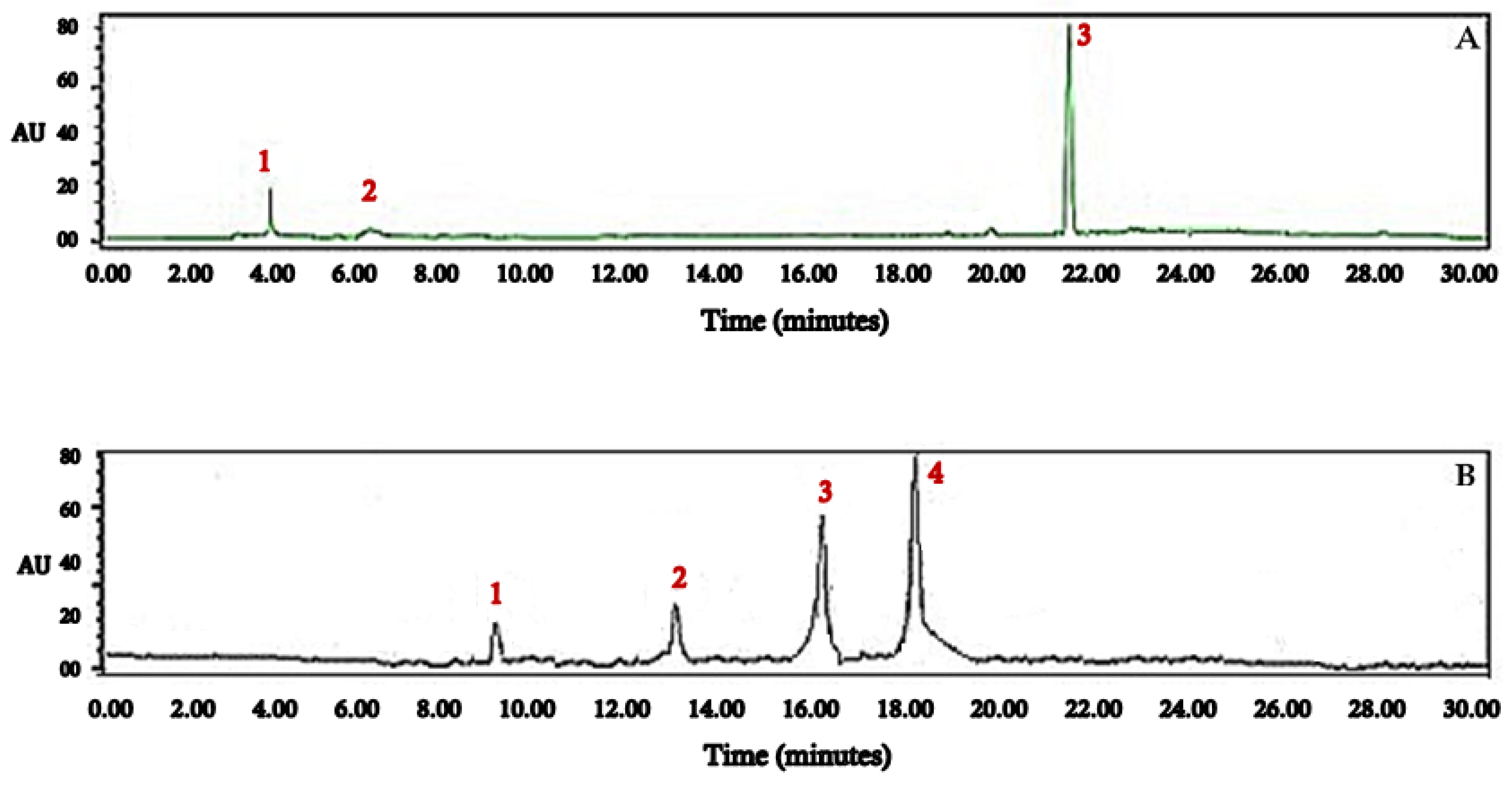
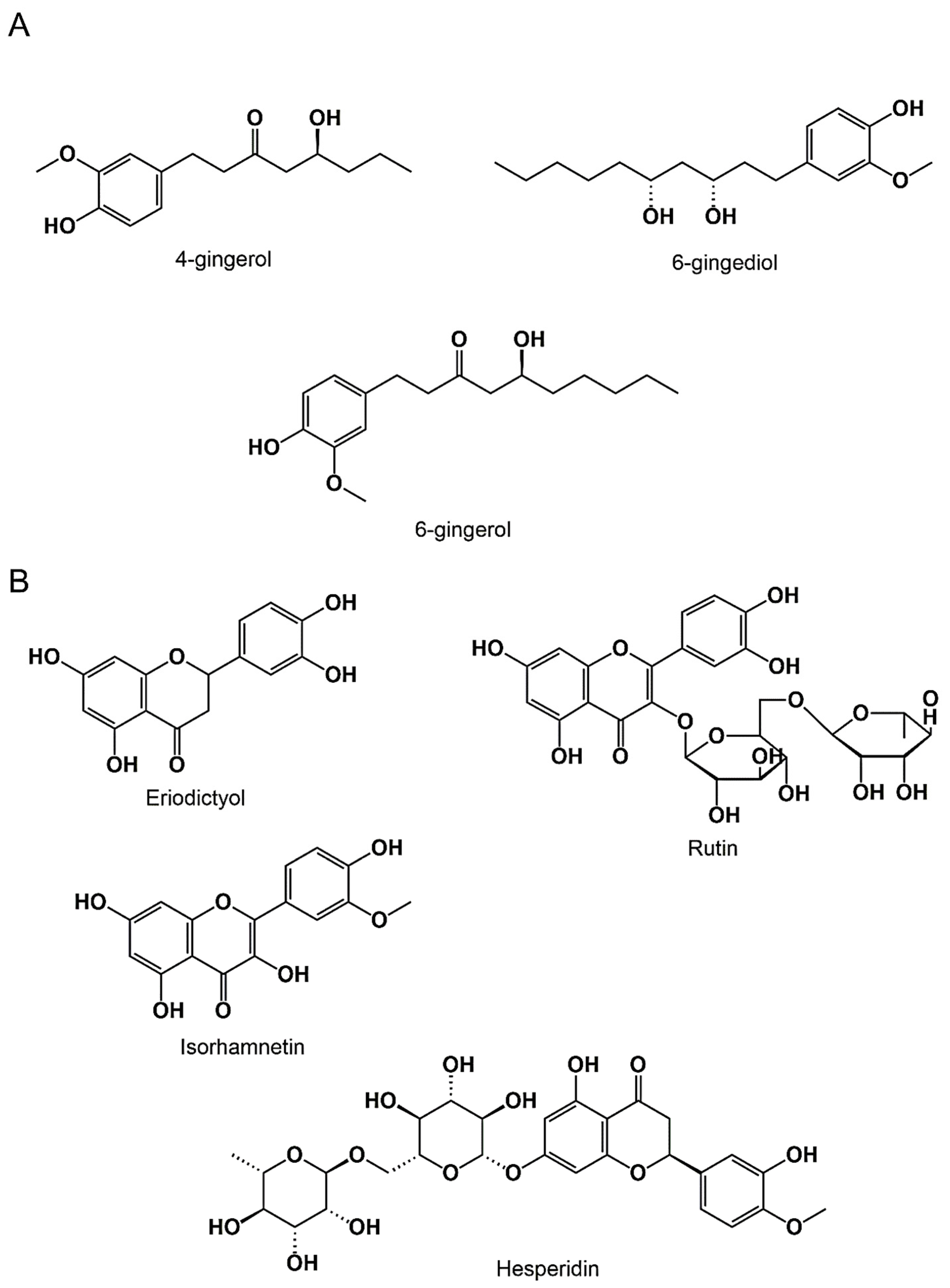
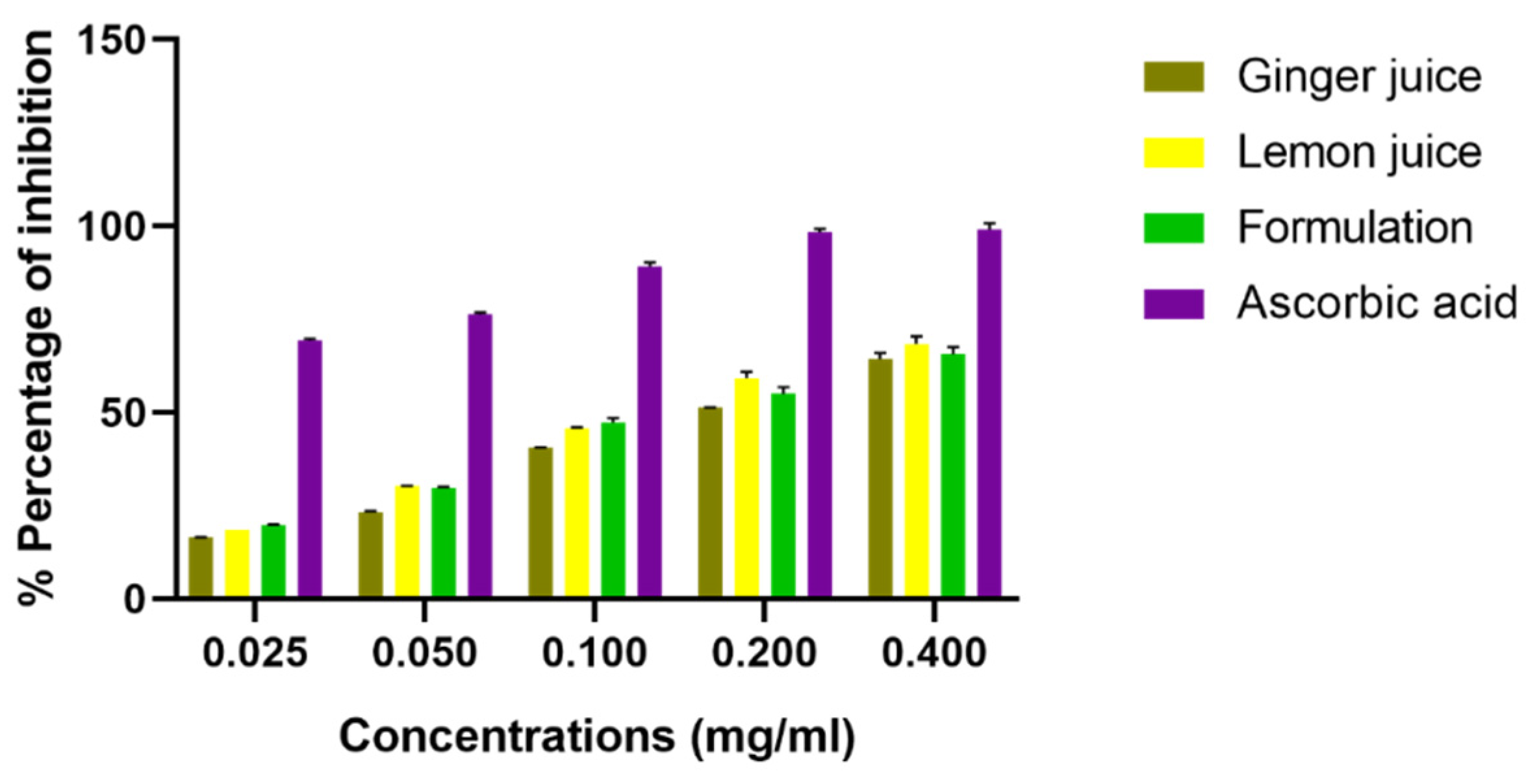

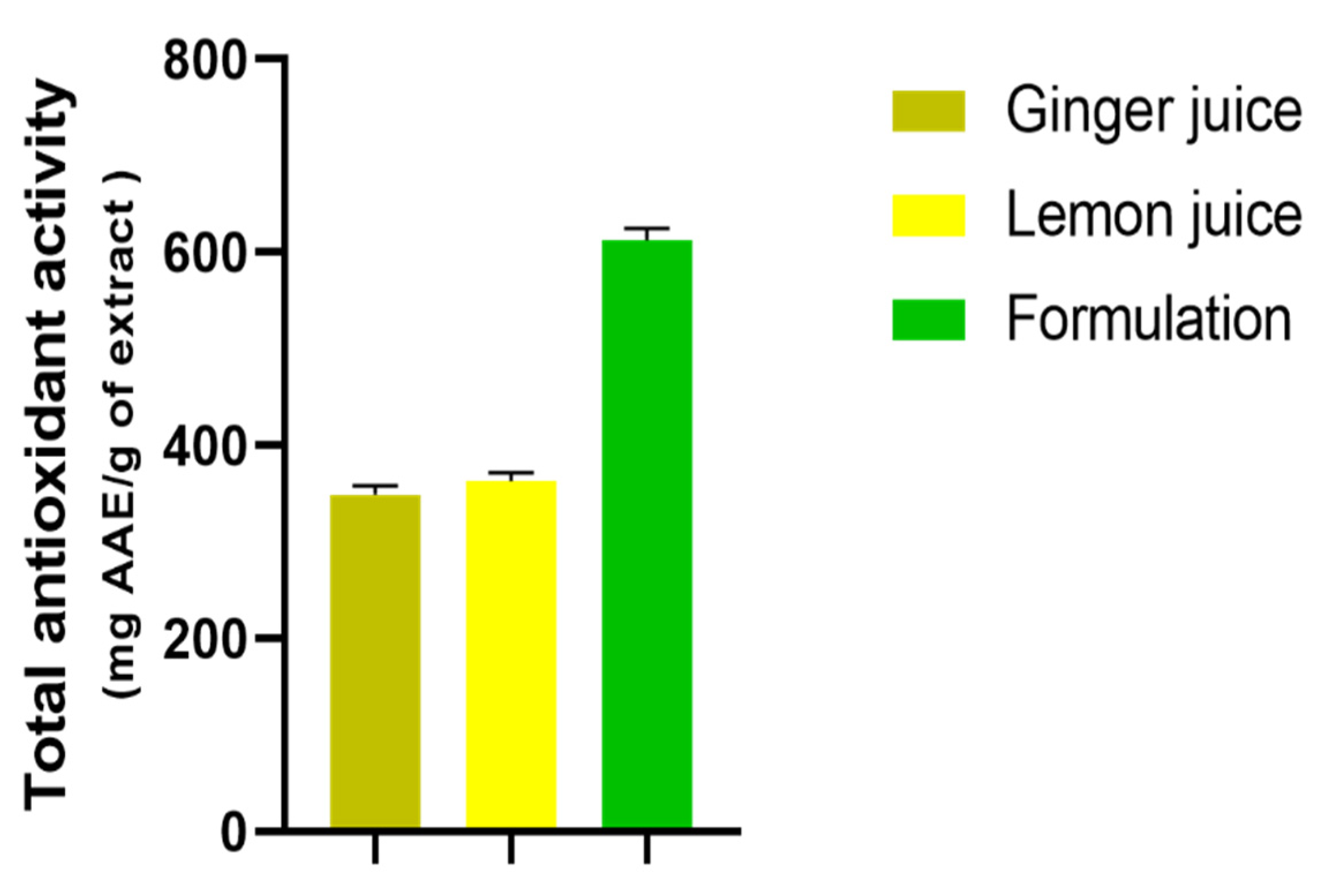
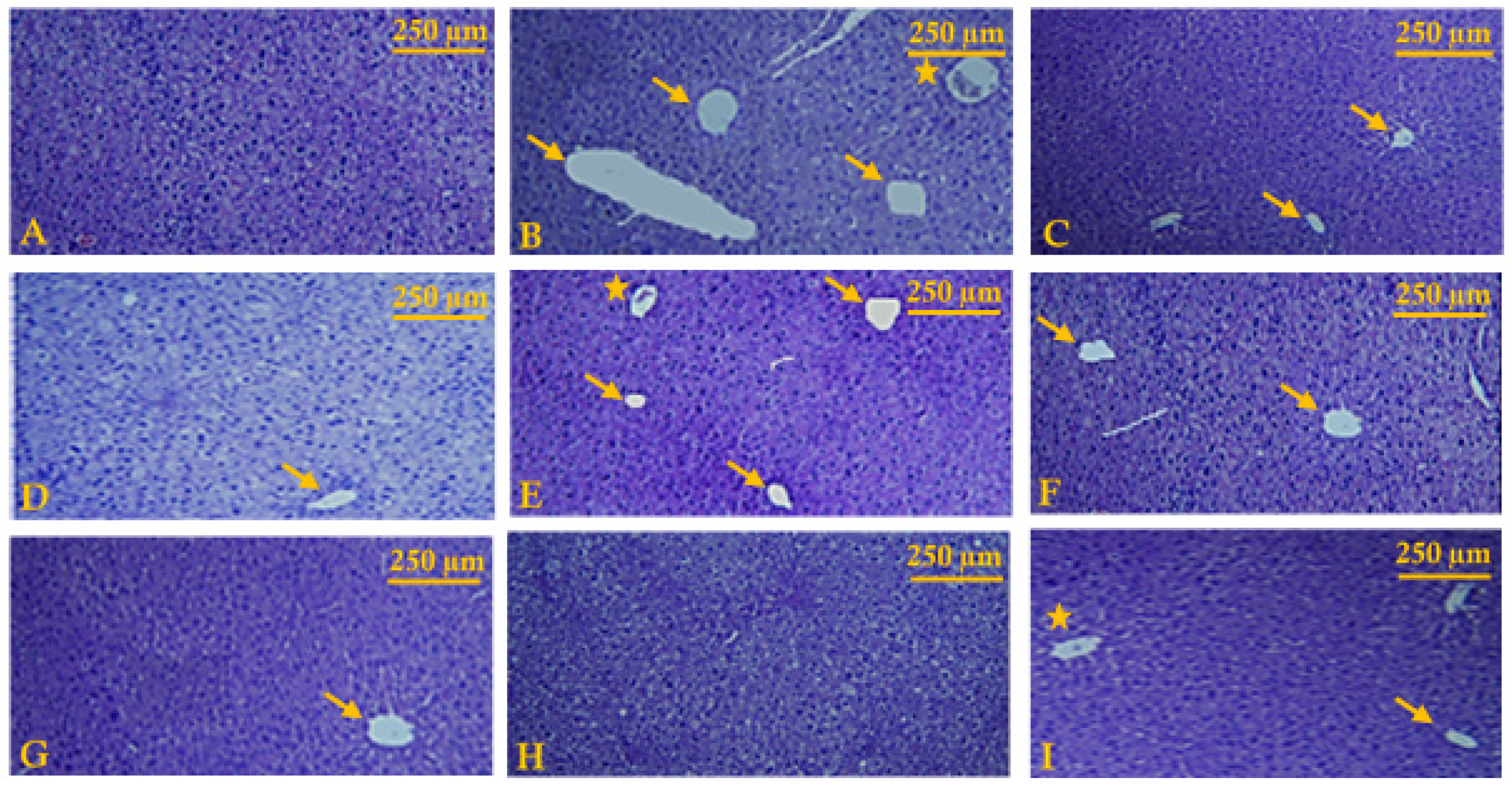
| GJ (mg GAE/g Extract) | LJ (mg QE/g Extract) | |
|---|---|---|
| Total polyphenol content | 18.48 ± 1.14 | 25.23 ± 1.54 |
| Total flavonoid content | 7.26 ± 2.05 | 12.75 ± 2.10 |
| (a) Peak Number | Compound | Retention Time (min) | % of Area |
|---|---|---|---|
| 1 | 4-gingerol | 3.97 | 0.81 |
| 2 | 6-gingediol | 6.41 | 0.19 |
| 3 | 6-gingerol | 21.60 | 15.22 |
| (b) Peak Number | Compound | Retention Time (min) | % of Area |
| 1 | eriodictyol | 9.17 | 3.12 |
| 2 | rutin | 13.25 | 5.69 |
| 3 | hesperidin | 16.31 | 13.88 |
| 4 | isorhamnetin | 18.23 | 18.43 |
| Rats Weight (g) | Liver Weight (g) | Liver Index (%) | |
|---|---|---|---|
| Control | 253.46 ± 3.85 | 6.85 ± 0.27 | 2.70 |
| CCl4 | 194.05 ± 4.21 a | 10.24 ± 0.31 a | 5.28 a |
| GJ 200 | 208.91 ± 3.65 c | 9.31 ± 0.22 c | 4.31 c |
| GJ 400 | 223.87 ± 5.72 a | 8.34 ± 0.40 b | 3.73 b |
| LJ 200 | 210.66 ± 2.33 c | 8.89 ± 0.28 b | 4.22 c |
| LJ 400 | 225.90 ± 4.91 a | 7.95 ± 0.71 a | 3.52 b |
| F 200 | 219.71 ± 2.27 b | 8.10 ± 0.35 a | 3.69 b |
| F 400 | 238.12 ± 3.98 a | 7.13 ± 0.86 a | 2.99 a |
| Silymarin | 225.36 ± 5.54 a | 7.77 ± 0.43 a | 3.45 b |
| ALP (u/L) | G-GT (u/L) | ALAT (u/L) | ASAT (u/L) | D-Bil (mg/L) | T-Bil (mg/L) | |
|---|---|---|---|---|---|---|
| Group 1 | 183.8 ± 5.37 | 3.20 ± 0.12 | 81.34 ± 1.75 | 90.10 ± 3.51 | 0.10 ± 0.01 | 1.00 ± 0.05 |
| Group 2 | 527.1 ± 10.4 a | 11.60 ± 0.85 a | 1583.9 ± 14.9 a | 5703.8 ± 11.6 a | 1.80 ± 0.05 a | 3.40 ± 0.31 a |
| Group 3 | 382.70 ± 6.14 a | 6.17 ± 0.55 a | 1469.3 ± 13.8 c | 1708.03 ± 15.5 a | 0.47 ± 0.05 a | 1.60 ± 0.03 a |
| Group 4 | 257.21 ± 5.42 a | 3.60 ± 0.15 a | 789.1 ± 10.3 a | 573.3 ± 11.6 a | 0.20 ± 0.01 a | 0.90 ± 0.02 a |
| Group 5 | 397.00 ± 8.23 a | 10.58 ± 1.02 NS | 1343.75 ± 12.7 c | 903.4 ± 12.3 a | 0.73 ± 0.04 a | 1.48 ± 0.07 a |
| Group 6 | 295.15 ± 4.87 a | 7.05 ± 0.80 b | 694.03 ± 9.79 a | 713.57 ± 9.94 a | 0.27 ± 0.01 a | 0.97 ± 0.03 a |
| Group 7 | 295.31 ± 7.08 a | 9.10 ± 0.79 c | 490.33 ± 9.63 a | 590.125 ± 10.1 a | 0.68 ± 0.07 a | 1.15 ± 0.07 a |
| Group 8 | 222.6 ± 6.98 a | 7.90 ± 0.46 b | 363.2 ± 3.65 a | 535.6 ± 7.54 a | 0.16 ± 0.01 a | 0.72 ± 0.03 a |
| Group 9 | 194.55 ± 5.72 a | 37.33 ± 1.81 a | 188.9 ± 6.54 a | 205.4 ± 8.12 a | 4.67 ± 0.73 a | 3.40 ± 0.25 a |
Publisher’s Note: MDPI stays neutral with regard to jurisdictional claims in published maps and institutional affiliations. |
© 2022 by the authors. Licensee MDPI, Basel, Switzerland. This article is an open access article distributed under the terms and conditions of the Creative Commons Attribution (CC BY) license (https://creativecommons.org/licenses/by/4.0/).
Share and Cite
Bekkouch, O.; Dalli, M.; Harnafi, M.; Touiss, I.; Mokhtari, I.; Assri, S.E.; Harnafi, H.; Choukri, M.; Ko, S.-J.; Kim, B.; et al. Ginger (Zingiber officinale Roscoe), Lemon (Citrus limon L.) Juices as Preventive Agents from Chronic Liver Damage Induced by CCl4: A Biochemical and Histological Study. Antioxidants 2022, 11, 390. https://doi.org/10.3390/antiox11020390
Bekkouch O, Dalli M, Harnafi M, Touiss I, Mokhtari I, Assri SE, Harnafi H, Choukri M, Ko S-J, Kim B, et al. Ginger (Zingiber officinale Roscoe), Lemon (Citrus limon L.) Juices as Preventive Agents from Chronic Liver Damage Induced by CCl4: A Biochemical and Histological Study. Antioxidants. 2022; 11(2):390. https://doi.org/10.3390/antiox11020390
Chicago/Turabian StyleBekkouch, Oussama, Mohammed Dalli, Mohamed Harnafi, Ilham Touiss, Imane Mokhtari, Soufiane El Assri, Hicham Harnafi, Mohammed Choukri, Seok-Jae Ko, Bonglee Kim, and et al. 2022. "Ginger (Zingiber officinale Roscoe), Lemon (Citrus limon L.) Juices as Preventive Agents from Chronic Liver Damage Induced by CCl4: A Biochemical and Histological Study" Antioxidants 11, no. 2: 390. https://doi.org/10.3390/antiox11020390
APA StyleBekkouch, O., Dalli, M., Harnafi, M., Touiss, I., Mokhtari, I., Assri, S. E., Harnafi, H., Choukri, M., Ko, S.-J., Kim, B., & Amrani, S. (2022). Ginger (Zingiber officinale Roscoe), Lemon (Citrus limon L.) Juices as Preventive Agents from Chronic Liver Damage Induced by CCl4: A Biochemical and Histological Study. Antioxidants, 11(2), 390. https://doi.org/10.3390/antiox11020390








